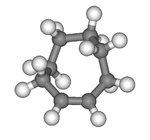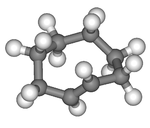Cyclooctene
 | |
| Names | |
|---|---|
| IUPAC names
(Z)-Cyclooctene (E)-Cyclooctene | |
| Other names
cis-Cyclooctene trans-Cyclooctene | |
| Identifiers | |
| 931-87-3 | |
| 3D model (Jmol) | Interactive image |
| ChemSpider | 553642 |
| ECHA InfoCard | 100.012.040 |
| PubChem | 638079 |
| |
| |
| Properties | |
| C8H14 | |
| Molar mass | 110.20 g·mol−1 |
| Density | 0.846 g/mL |
| Melting point | −16 °C (3 °F; 257 K) |
| Boiling point | 145 to 146 °C (293 to 295 °F; 418 to 419 K) |
| Except where otherwise noted, data are given for materials in their standard state (at 25 °C [77 °F], 100 kPa). | |
| Infobox references | |
Cyclooctene is a cycloalkene with an eight-membered ring. It is notable because it is the smallest cycloalkene that can exist as either the cis- or trans-isomer with the cis-isomer more common. Its most stable cis stereoisomer can adopt various conformations, the most stable one being shaped like a ribbon;[2] its most stable trans-conformer is shaped like the 8-carbon equivalent chair conformation of cyclohexane.
 |  |
| cis-Cyclooctene | trans-Cyclooctene |
cis-Cyclooctene
cis-Cyclooctene (COE) is a substrate notoriously known for quite selectively forming the epoxide, as compared to other cycloalkenes, e.g. cyclohexene. Low amounts of radical by-products are found only. The reason for this behaviour is that allylic functionalization in cis-cyclooctene is more difficult than for other cycloalkenes, because of almost orthogonal allylic C-H bonds. Therefore, if radicals are around, they rather form epoxide (via an addition-elimination mechanism) than to form allylic byproducts.[2] It is used as an easily displaced ligand in organometallic chemistry, e.g. chlorobis(cyclooctene)rhodium dimer and chlorobis(cyclooctene)iridium dimer.
trans-Cyclooctene
trans-Cyclooctene is the smallest cycloalkene in which the trans-isomer is stable at room temperature. This is because trans-cycloalkenes have a longer bridging distance between the two allylic carbons than their respective cis-cycloalkenes. Eight carbons is the minimum ring size required to join them when they are trans without causing severe structural strain. The smaller rings of trans-Cycloheptene and trans-cyclohexene can exist, but they are very unstable at room temperature. trans-Cyclooctene exists in a helical conformation with the carbon chain lying above the double bond on one side and below it on the other, leading to chirality (as depicted to the right). This type of chirality is defined as planar chirality. There are two enantiomeric forms, atropisomers resulting from restricted rotation about a single bond.[3]
trans-Cyclooctene was first synthesized on a preparatory scale by Arthur C. Cope with a Hofmann elimination reaction of N,N,N-trimethylcyclooctylammonium iodide.[4] The reaction gives a mixture of cis and trans isomers, and the trans isomer is selectively trapped as a complex with silver nitrate. Other methods exist where the trans-isomer is synthesized from the cis-isomer in several synthetic steps. In addition, a photochemical method exists for the direct cis–trans isomerisation:
Although this is an equilibrium that strongly favours the more stable cis form, the reaction can be driven towards the trans by trapping with silver.[5]
References
- ↑ "cis-Cyclooctene". Sigma-Aldrich.
- 1 2 Neuenschwander, Ulrich; Hermans, Ive (2011). "The Conformations of Cyclooctene: Consequences for Epoxidation Chemistry". J. Org. Chem. 76 (24): 10236–10240. doi:10.1021/jo202176j.
- ↑ IUPAC, Compendium of Chemical Terminology, 2nd ed. (the "Gold Book") (1997). Online corrected version: (2006–) "Planar chirality".
- ↑ Cope, Arthur C.; Bach, Robert D. (1969). "trans-Cyclooctene". Org. Synth. 49: 39.; Coll. Vol., 5, p. 315
- ↑ Royzen, Maksim; Yap, Glenn P. A.; Fox, Joseph M. (2008). "A Photochemical Synthesis of Functionalized trans-Cyclooctenes Driven by Metal Complexation". J. Am. Chem. Soc. 130 (12): 3760–3761. doi:10.1021/ja8001919.